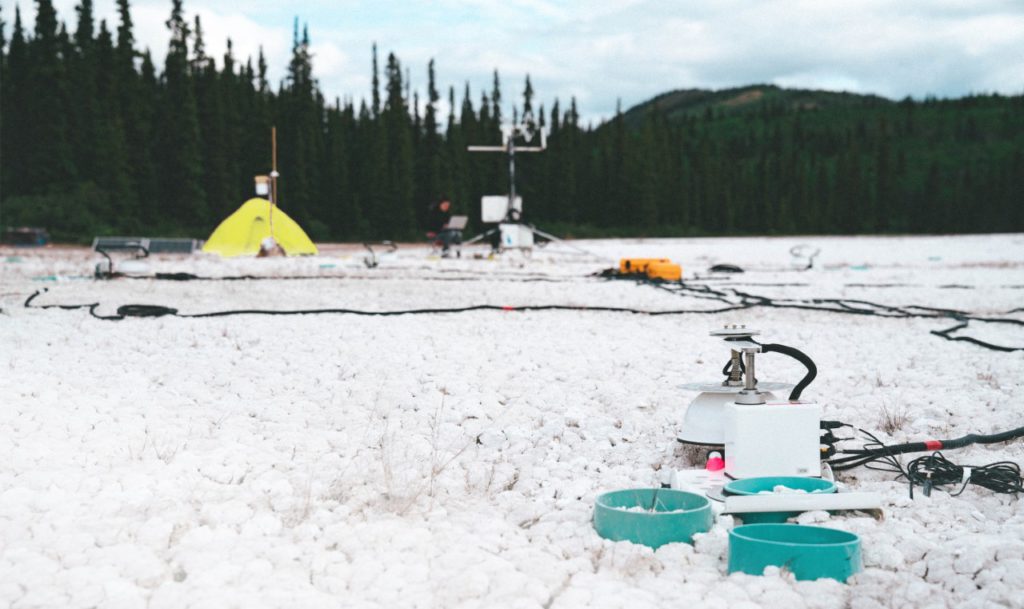Amanda Stutt | February 24, 2023 |

Arca technology at work on a mine site. Image from Arca.
The clean energy transition is one of the biggest buzz-phrases in the industry, as miners race to reach decarbonisation goals.

A recently rebranded company, Arca, spun out of Carbin Minerals, which started in 2018 at the University of British Columbia (UBC) has discovered that certain types of mine tailings can remove carbon from the atmosphere more quickly than anyone previously thought. And that ultramafic rock can capture and store gigatonnes of CO2.
The company was named last year as one of Canada’s most investable cleantech ventures, and won a $1 million award from XPRIZE and the Musk Foundation in a carbon removal competition. Arca is already collaborating with 11 mining companies and pre-sold over C$1 million worth of carbon dioxide removal credits.
“We work with rocks that are naturally reactive – they aren’t reactive when they’re in the ground, they become reactive when they’re mined, but we have a portfolio of technologies that makes sure that we capitalize on the huge reactive capacity of those materials, once they end up as mined waste,” UBC Professor of Geological Sciences and co-founder and Head of Science at Arca Greg Dipple told MINING.com.
Dipple noted the mineral content of the host rock is key, and that the technology works in ultramafic rocks, which are rich in magnesium silicate.
Arca’s technology accelerates carbon mineralization, the transformation of atmospheric CO2 into stable carbonate materials and it partners with producers of critical metals to transform their mine waste into industrial-scale direct air capture and storage facilities.
Massive “carbon sink”
“After decades of fundamental scientific research, in the lab and in the field, we have discovered new ways to transform mine waste into a massive carbon sink,” Dipple said. “Our mineral activation technology significantly accelerates the natural process of carbon mineralization, transforming mine waste into a valuable new resource and climate solution.”

UBC professor of Geological Sciences and Arca Head of Science Greg Dipple.
Dipple said the process captures carbon dioxide directly from the air above the mine and it stores it in mineral form where it is stable over geologic time.
“It’s a permanent, dense form of storage of carbon that ultimately ends up under the landscape upon mine closure,” he said. “When the mines are closed and the landscape is restored, all that carbon is stored in the subsurface permanently from the perspective of our lifetimes, stored on geologic timescales.”
It operates on a scale that can be on par with energy use within existing mines.
“We look at the way that mines are being transformed now to deploy renewable electricity and decarbonize their haul feet,” he said. “In the context of those technologies, our technologies will allow operating mines to get rid of the last 10-20% of their emissions that are hard to abate and go beyond that, such that a mine that’s designed with renewable energy and [a] decarbonized haul fleet.”
“A nickel mine, for example, could operate so that achieving a net negative carbon impact – so it will actually be a source of carbon renewal from the atmosphere while providing zero carbon metals for the energy transition.”
Arca CEO Paul Needham pointed out the clean energy transition presents a challenge and a paradox.
“On the one hand, the world will need 10-20 times more nickel and other critical metals to successfully transition to clean energy,” Needham said in a statement. “On the other hand, modern mining processes are carbon intensive. We resolve that paradox by providing a pathway to carbon-negative mining.”
Dipple said this is being proven during baseline studies at operating mines.
“One of the mines we’ve worked at, a large nickel mine in Australia is doing 40,000 tonnes per year we accelerate that three to four times with our technologies, and we can go beyond that,” he said. “If that mine were to reduce its emissions through 100% deployment of renewable for its electricity generation and if it decarbonized its haul fleet, it would already be carbon negative.”
Dipple noted that there is a disconnect between the public perception of mining as a dirty, polluting industry and the reality of the state of the future of mining.
“I think it’s one of the major issues facing the mining sector – facing society at large, because if we don’t provide the metals that we need for the clean energy transition – it’s simply not going to happen,” he said.
No comments:
Post a Comment